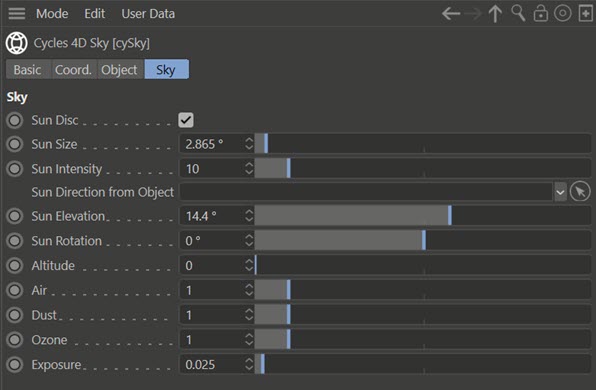Sky Object
 The cySky object is a new object which takes a material using the Nishita Sky texture node. With it you can produce results like this:
The cySky object is a new object which takes a material using the Nishita Sky texture node. With it you can produce results like this:

This scene uses only a Sky object plus a Plane and two Spheres.
Note that the Sky object is essentially a wrapper for a cyEnvironment object with a Nishita Sky texture applied, so you could create the same effect using a cyEnvironment object and adding the texture to it manually. However, the Sky object is easier to set up and offers access to the material settings from its interface, rather than having to open the node editor.
Interface
The Sky object interface has two tabs:
Parameters
Object tab

These parameters are those found in the Object tab of the cyEnvironment object. Please refer to the manual page for that object for full details.
Sky tab

These parameters are those found in the Nishita Sky texture node. Please refer to the manual page for that node for full details. If you change any of these parameters, the node will automatically be updated. In the same way, if you edit the node, any changes will be duplicated in this object.
Using the Sky object
Creating and using the object is very simple but one issue you may encounter is positioning the sun exactly where you want it. To do this it is recommended that you use the 'Sun Direction From Object' feature.
To use this feature, create an object - a Null object, which won't be rendered, is fine. Drag this into the link field. You will notice instantly that the sun disc vanishes and the scene goes very dark. This is because the Null is at the world centre. To fix this, move it out a long way - e.g. 5000 scene units - on the X or Z axes. Now the disc reappears. You can now move the Null to position the sun, but we can get finer control than this.
Create a second Null and leave it at the world centre. Make the first Null a child of the new one. Now, to move the sun, rotate (don't move) the parent Null and you can position the sun very easily and quickly. You don't need to rotate or move the child Null at all.